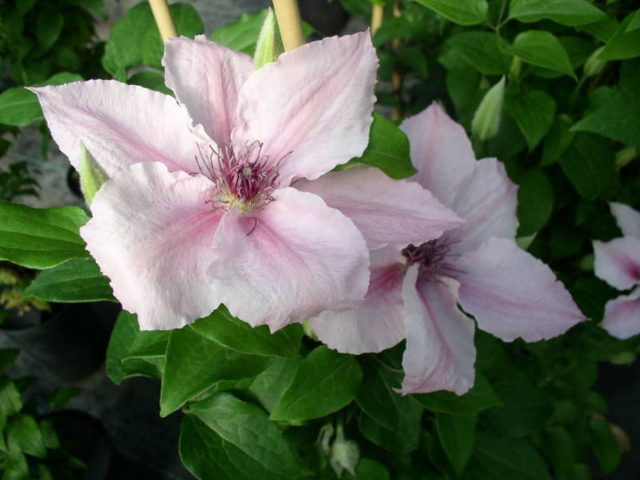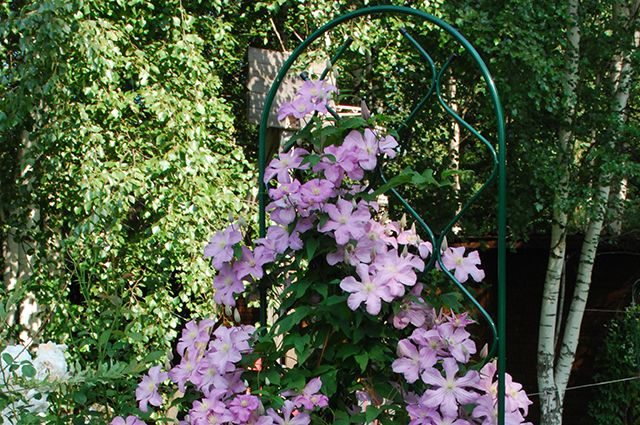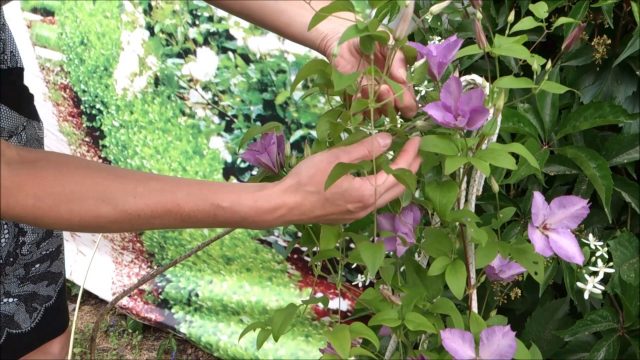Content
Large-flowered clematis Ruran outwardly does not look like representatives of the species. An elegant, weaving handsome man looks spectacular on the site, so designers often use it to create complex garden compositions. In order for an unusual variety to take root in the conditions of the domestic climate, you need to know the rules of cultivation.
Description of Clematis Ruran
A bright hybrid of Japanese breeding is easy to recognize by its huge buds that smell good. Large pink petals with dark veins and pointed tips. The hue smoothly transitions from white to maximum saturation. If the care is correct, then the flowers will delight you with gigantic sizes - up to 18 cm in diameter. Purple stamens are located around the tiny pistil.
Clematis Ruran, graceful in the description and in the photo, is a weaving liana, the length of which ranges from 2 to 3 m. Green oval plates with a pleasant glossy sheen and noticeable veins are collected on petioles. The variety belongs to the type of frost resistance 4A. If properly prepared for winter, it can endure up to -30 C.
Clematis pruning group Ruran
In order to maintain health and decorative appearance, the shoots of climbing plants should be regularly pruned. A beautiful hybrid is included in the 2nd pruning group. Vines form buds on last year's and fresh branches. The shortening procedure is carried out twice:
- In May-June, Clematis Ruran dissolves petals on old lashes. In the summer, shoots of the last year are cut. The procedure stimulates the young to awaken the buds.
- After the first frost and before shelter for the winter, strong branches are shortened by a third, leaving at least 50-100 cm from the ground. In the spring, healthy specimens of large-flowered clematis Ruran will quickly wake up, begin to build up a green mass, and open the petals. So that the weak parts do not pull off the nutrients, the thin, painful ones must be destroyed.
With competent agricultural technology, flowering stretches into two stages. At the beginning of the season, Clematis Ruran, as in the photo, will delight you with huge buds. In August and September, the decorative process of the vine is not so abundant and long, and the diameter of the petals does not exceed 15 cm.
Planting and caring for hybrid clematis Ruran
Clematis prefers sunny places, protected from drafts and strong gusts of wind. The upper parts of the plant love intense light, while the lower stems, roots, shade. Not recommended to grow near houses, tall buildings and spreading trees. Liana will be more comfortable next to bushes, medium-sized crops.
Gentle Clematis Ruran prefers to develop in nutritious soil. Loam and sandy loam are suitable, they are perfectly permeable to air and water. The hybrid is not picky about the pH of the soil, therefore it takes root equally well in both slightly acidic and slightly alkaline environments. Planting in a permanent place of growth is carried out in early spring and autumn, withstands cultivation in bulk containers.
Dig a hole according to the size of the roots. For clematis Ruran, the standard scheme of 60x60x60 cm is suitable.The plant does not like stagnation of water at the lower parts, therefore at least 15 cm of drainage (broken brick, expanded clay) is poured onto the bottom of the pit. A bucket of humus mixed with 1 liter of wood ash and 100 g of complex fertilizer is added.
A small hill is poured onto a nutritious pillow, on which a young specimen is planted. The root collar is set 5 cm above ground level. It is poured abundantly with warm water, mulched with peat, sawdust.
Ruran's weaving clematis must be fixed on a support. The trellis is carefully dug in on the sides of the bush. If the vine is used for vertical gardening of the gazebo, then it is planted near the structure. Clematis grows up to 3 m, so it will decorate any structure.
Flowering plants need to be fertilized frequently. In the first year, seedlings use nutrient reserves from the planting pit. The introduction is carried out in the spring after wintering. Bright Clematis Ruran is fed during the entire growing season, every 14 days. Mineral preparations alternate with rotted organic substances. After pruning, young lashes are stimulated by leaf processing.
If clematis does not have enough water, then the buds become smaller. The plant will not withstand the sweltering heat, therefore, it can shorten the duration of flowering. 10 liters is enough for seedlings, and at least 2 buckets for adult clematis Ruran. In the evening, be sure to sprinkle greens with a spray bottle with a small drop.
Preparing for winter
Lianas of the second pruning group winter with shoots, so it is important to preserve the integrity of the branches. After the first cold weather, the clematis lashes of the Ruran variety are carefully twisted into an arc, fixed at the ground. From above, the plant is covered with coniferous spruce branches, fallen leaves. If the temperature in the region drops to -30 C, then the structure is additionally protected with agrofibre. To prevent the bush from blowing out, the structure is removed in the spring.
Clematis Ruran is a frost-resistant crop whose roots are sensitive to cold. In mid-autumn, the root circle is covered with 15 cm of mulch, consisting of:
- loose soil;
- humus;
- peat;
- sawdust.
Reproduction
Large-flowered hybrids rarely retain the characteristics of the variety when sown. To get a beautiful vine with huge buds, it is better to use the division method. An adult bush is dug out of the ground, cleaned of soil and cut with a sharp knife along the root. Children with noticeable kidneys take root.
After summer and autumn pruning, high-quality lashes can be cut into cuttings. Branches without greenery are shortened, leaving 2-3 eyes. Blanks of Ruran clematis are placed in a hole with peat, mulched, watered abundantly. If the raw materials are cut for the winter, then spruce branches are protected from frost from above. Irrigation is carried out only in spring, the shelter is removed.
Reproduction by layering is a simple method for obtaining young clematis of the Ruran variety at home. The faded lash is fixed in a pot with earth. The plant is abundantly moisturized, warm water and root formation stimulants are used. In the fall, seedlings can be transplanted to a new location.
Diseases and pests
Hybrid clematis Ruran has strong immunity, so it rarely gets sick. Fungi remain typical species diseases. Spores of the pathogen are not afraid of frost, and in the spring they affect a weakened bush. First, the roots are destroyed, then the foliage is affected. The culture can be protected by preventive treatments with fungicides, dressing the earth with Bordeaux liquid.
Pests move to Clematis Ruran from neighboring plants. Migratory aphids love young foliage, shoots. Dry air becomes an excellent environment for the development of spider mites and scale insects. Excess moisture attracts slugs and snails. In winter, rodents settle in protective shelters, gradually destroying roots and whips.
Conclusion
Clematis Ruran hybrid is a beautiful plant that is suitable for vertical gardening of the site. The graceful climbing shrub can be propagated at home. If you indulge in small whims, then the Japanese variety of creepers will delight you with huge smelling buds.
Reviews of Clematis Ruran











